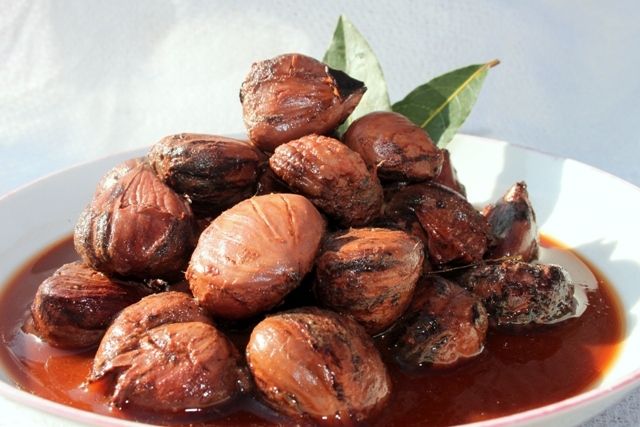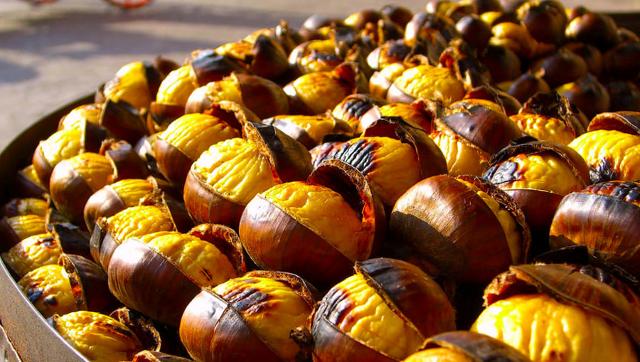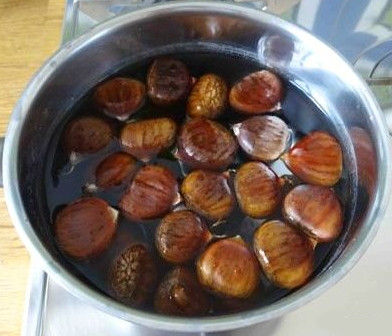Il nostro territorio è completamente immerso nella natura e da sempre ci ha offerto questo prezioso e dolcissimo frutto che è il simbolo della nostra tradizione montanara. Noi le castagne le mangiamo fin da piccoli, e non è solo un modo di dire, infatti i nostri nonni le trasformavano in farina con cui impastavano pane, pasta, ecc. Vi proponiamo, quindi, tre semplici ricette della cultura contadina che abbiamo imparato dalle sapienti mani delle nostre nonne e che tutt’ora arricchiscono e rallegrano le nostre tavole…tre modi diversi di cucinare le castagne, tre modi semplici di volersi bene.
Our territory is completely immersed in nature and has always offered us this precious and sweet fruit which is the symbol of our mountain tradition. We eat chestnuts from an early age, and this is not just a saying, in fact our grandparents transformed them into flour with which they kneaded bread, pasta, etc. We therefore offer you three simple recipes of peasant culture that we learned from the skilled hands of our grandmothers and that still enrich and brighten our tables … three different ways of cooking chestnuts, three simple ways of loving yourself.

R’ LESS (castagne bollite).
Il modo tradizionale di cucinare le nostre castagne è quello di bollirle senza la buccia esterna. Spellare le castagne rimuovendo la prima buccia, quella esterna e più dura, lasciando invece la pellicina sottile. Portare a bollore una pentola d’acqua con foglie di alloro ed un pizzico di sale e immergere le castagne nell’acqua bollente. Appena il desiderio di assaggiarle si fa irrefrenabile…beh è il momento di scolarle.
Boiled Chestnuts
The traditional way of cooking our chestnuts is to boil them without the external peel. Peel the chestnuts by removing the first peel, the outer and harder one, leaving the thin skin instead. Bring a pot of water with bay leaves and a pinch of salt to the boil and immerse the chestnuts in boiling water. As soon as the desire to taste them becomes unstoppable … well it’s time to drain them.

R’MUDDITL (castagne arrostite)
Forse il modo più sfizioso per cucinare le nostre castagne è quello di arrostirle. Per chi come noi, in casa ha un caminetto, la cottura su brace è un momento appassionante. Per chi deve cuocerle in forno la procedura è semplice, preriscaldate il forno a 220° C e inserite la teglia con le castagne fino alla loro cottura. Sulla brace invece serve una padella bucherellata e tanta attenzione, il segreto in questo caso è quello di coprire le castagne con un canovaccio umido. Ah…non dimenticate “la croce”. Su ogni castagna che vorrete arrostire vi tocca fare un taglietto a croce…non ve ne pentirete.
Roasted Chestnuts
Perhaps the most delicious way to cook our chestnuts is to roast them. For those of us who have a fireplace at home, cooking on embers is an exciting moment. For those who have to cook them in the oven, the procedure is simple, preheat the oven to 425° F and insert the pan with the chestnuts until they are cooked. On the grill instead you need a pan with holes and a lot of attention, the secret in this case is to cover the chestnuts with a damp cloth. Ah… do not forget “the cross”. On each chestnut you want to roast you have to make a cross cut … you will not regret it.

I VADNI (castagne bollite)
Una proposta semplice ma gustosissima. In una pentola con acqua fredda si immergono le castagne con tutta la buccia, integre, qualche foglia di alloro e un pizzico di sale. Portare a bollitura e far cuocere finché le castagne risultino elastiche al tatto.
Boiled Chestnuts
A simple but very tasty proposal. In a pan with cold water, immerse the chestnuts with all the peel, intact, a few bay leaves and a pinch of salt. Bring to the boil and cook until the chestnuts are elastic to the touch.
